
Lawrenceville is one of the largest neighborhood areas in Pittsburgh in the U.S. state of Pennsylvania. It is located northeast of downtown, and like many of the city's riverfront neighborhoods, it has an industrial past. The city officially divides Lawrenceville into three neighborhoods, Upper Lawrenceville, Central Lawrenceville, and Lower Lawrenceville, but these distinctions have little practical effect. Accordingly, Lawrenceville is almost universally treated as a single large neighborhood.
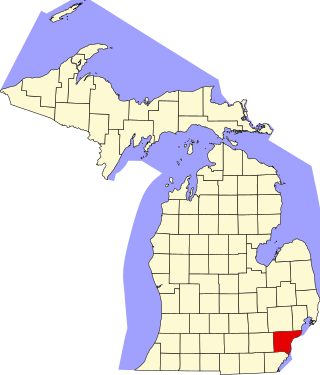
This is a list of the National Register of Historic Places listings in Wayne County, Michigan.

The Allegheny Arsenal, established in 1814, was an important supply and manufacturing center for the Union Army during the American Civil War, and the site of the single largest civilian disaster during the war. It was located in the community of Lawrenceville, Pennsylvania, which was annexed by the city of Pittsburgh in 1868.
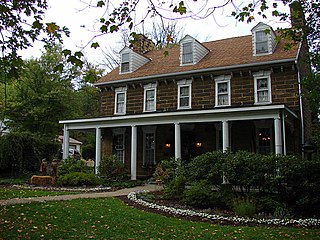
Hill's Tavern is a historic building in Scenery Hill, Pennsylvania. It was heavily damaged by a fire that started shortly before midnight on August 17, 2015. For a period in the early 1900s, the inn was known as Central Hotel. Now called the Century Inn, it has been claimed to have been the oldest tavern in continuous use on the National Road, until the fire brought an end to its 221 years of continuous operation.

The Arsenal School is a historic school building in the Lower Lawrenceville neighborhood of Pittsburgh, Pennsylvania. It houses both a middle school, Arsenal 6–8, and an elementary school, Arsenal PreK–5, operated by Pittsburgh Public Schools. The building originally opened in 1932 as a junior high school, with the elementary school addition completed in 1939. It stands on part of the former site of the Allegheny Arsenal.

The Lawrence Public School, which is located in the Lawrenceville neighborhood of Pittsburgh, Pennsylvania, was built in 1872 and served as an elementary school, including instruction in the German language.
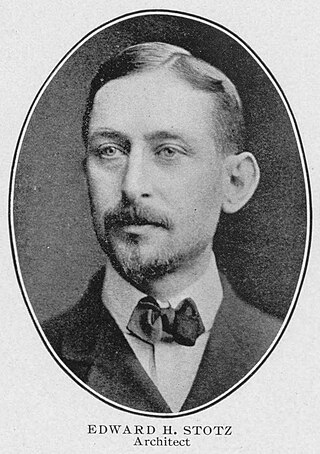
Edward Stotz Sr. (1868–1948) was an American architect who was based in the city of Pittsburgh in the Commonwealth of Pennsylvania. He designed numerous buildings during the late nineteenth and early twentieth centuries that are now listed as significant by the National Register of Historic Places and the Pittsburgh History and Landmarks Foundation.
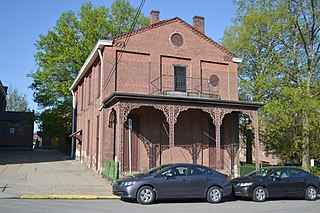
The Saint Mary's Academy Building is a historic building in the Lawrenceville neighborhood of Pittsburgh, Pennsylvania. Built in 1854, it is a notable example of Greek Revival architecture and one of the neighborhood's only surviving buildings dating to the pre–Civil War era. It was the first structure built by St. Mary's parish, the first Catholic parish in Lawrenceville, and was originally used as both a church and school. In 1874, a new St. Mary's Church was built next door. St. Mary's merged with three other Lawrenceville parishes in 1993 to form the new Our Lady of Angels parish. The St. Mary church buildings remained in use for a few years but closed in 2004.

The Historic Moravian Bethlehem Historic District encompasses a complex of the oldest surviving buildings in Bethlehem, Pennsylvania. The National Historic Landmark District is a subset of the larger Central Bethlehem Historic District which is specifically focused on the early buildings constructed by the Moravians, who settled the city in the 18th century.

Castroville Historic District is a United States historic district in Castroville, Texas. It includes the oldest parts of the city of Castroville and contains twelve designated contributing properties, including a Texas State Historic Site and numerous Recorded Texas Historic Landmarks. The district was listed on the National Register of Historic Places in 1970.

St. Mary's Church is an historic, former American Catholic church that is located in the Lawrenceville neighborhood of Pittsburgh, Pennsylvania.

St. Augustine Church is a historic Roman Catholic church in the Lawrenceville neighborhood of Pittsburgh, Pennsylvania. It has remained in use as a parish church since construction, currently serving Saint Pio of Pietrelcina Parish, which with St. Maria Goretti forms the Bloomfield/Garfield/Lawrenceville Grouping within the Diocese of Pittsburgh. The church has been operated by the Capuchin Friars since 1873 and is the headquarters of the Capuchin Province of St. Augustine.

The Former Pittsburgh Wash House and Public Baths Building is located at 3495 Butler Street in the Lawrenceville neighborhood of Pittsburgh, Pennsylvania. Built in 1904 in the Romanesque Revival architectural style, the building today serves as office space. The bath house was designated a Pittsburgh historic landmark in 2018 and was listed as a contributing property in the Lawrenceville Historic District in 2019.

Holy Family Church is a historic former Roman Catholic church in the Lawrenceville neighborhood of Pittsburgh, Pennsylvania, and a contributing property in the Lawrenceville Historic District. The church was built in 1939–40 and was designed in the Romanesque Revival architectural style with modernist design principles.

The Turney House is a historic house in the Lawrenceville neighborhood of Pittsburgh, Pennsylvania, and a designated Pittsburgh historic landmark. It was built circa 1851 by Lucian B. Turney, a carpenter who also served on the Lawrenceville Borough Council during the 1850s. It was also the residence of Turney's daughter Margaret, who at age 17 was one of 78 workers killed in the 1862 Allegheny Arsenal Explosion, the deadliest civilian disaster during the U.S. Civil War. After the demolition of 184 38th Street in 2011, the Turney House is the only surviving house known to be associated with a victim of the explosion. Another one of Turney's children, Olive, became a successful artist. In 1996, the house was purchased by architectural historian Carol Peterson, who restored it to a period-appropriate appearance.

Naser's Tavern is a historic building in the Lawrenceville neighborhood of Pittsburgh, Pennsylvania, and a designated Pittsburgh historic landmark. It is thought to be the oldest surviving building on Butler Street, the main commercial street in Lawrenceville. The structure was probably built by John Kingan between 1833 and 1846, as the price of the property when Kingan sold it indicates there was already a substantial building on the site. At the time, it was at the edge of the built-up area of Butler Street, which spanned approximately one block on either side of the Allegheny Arsenal. John Naser, a German immigrant, bought the property in 1846 and operated an inn and tavern there which he called "Our House". His son Charles took over the business in the 1870s and expanded the building with several additions, including a second floor which was built sometime between 1893 and 1905. The Naser family sold the building in 1943. As of 2018 it houses a branch of Pennsylvania's state-run liquor store, Fine Wine & Good Spirits.

The Lawrenceville Historic District is a U.S. historic district in Pittsburgh, Pennsylvania, which encompasses the majority of the Lawrenceville neighborhood. The historic district includes 3,217 contributing resources, many of which are rowhouses, commercial buildings, and former industrial properties built between the 1830s and early 20th century. The district was listed on the National Register of Historic Places in 2019.

The Pennsylvania National Bank Building is a historic building in the Lawrenceville neighborhood of Pittsburgh, Pennsylvania. It is located on a prominent site facing Doughboy Square, the acute intersection of Butler Street and Penn Avenue which is often considered the "entrance to Lawrenceville".
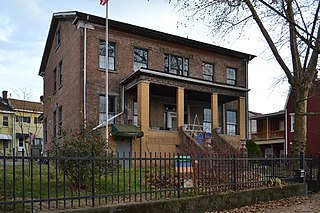
The Mowry-Addison Mansion is a historic house in the Upper Lawrenceville neighborhood of Pittsburgh, Pennsylvania, and a contributing property in the Lawrenceville Historic District. It was built in 1830–32 by Peter Mowry, a physician, and was originally part of a large estate that was subdivided into residential lots in 1872. The house is notable as a rare example of relatively well preserved Greek Revival architecture in Pittsburgh, and exemplifies the typical pattern of development in Lawrenceville in the mid to late 19th century. In 2020, the building was nominated as a Pittsburgh historic landmark by Preservation Pittsburgh, which stated that the mansion "is one of the last remaining and most significantly preserved regional ribbon farm dwellings from its period of construction."

The Ewalt House was a historic house in the Lawrenceville neighborhood of Pittsburgh, Pennsylvania, and a contributing property in the Lawrenceville Historic District. It was built as a country estate sometime between 1787 and 1840 by Samuel Ewalt, and remained standing after most of the land was subdivided for residential lots in the 1870s. The house was notable as a rare example of an antebellum style Greek Revival house in Pittsburgh, and exemplified the typical pattern of development in Lawrenceville in the mid to late 19th century. In 2019, the building was nominated as a Pittsburgh historic landmark.





















